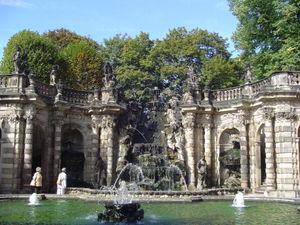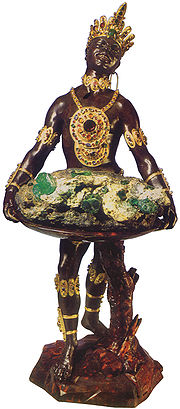
Balthasar Permoser
Encyclopedia


Baroque
The Baroque is a period and the style that used exaggerated motion and clear, easily interpreted detail to produce drama, tension, exuberance, and grandeur in sculpture, painting, literature, dance, and music...
and early Rococo
Rococo
Rococo , also referred to as "Late Baroque", is an 18th-century style which developed as Baroque artists gave up their symmetry and became increasingly ornate, florid, and playful...
.
Permoser was born in Kammer bei Waging, Salzburg
Salzburg
-Population development:In 1935, the population significantly increased when Salzburg absorbed adjacent municipalities. After World War II, numerous refugees found a new home in the city. New residential space was created for American soldiers of the postwar Occupation, and could be used for...
, today a part of the Bavarian town of Traunstein
Traunstein
Traunstein is a town in the south-eastern part of Bavaria, Germany, and is the administrative center of a district by the same name. It is situated at the heart of a region called Chiemgau, approximately 11 km east of Lake Chiemsee between Munich and Salzburg, 15 km north of the Alps, and...
. He was trained first in Salzburg
Salzburg
-Population development:In 1935, the population significantly increased when Salzburg absorbed adjacent municipalities. After World War II, numerous refugees found a new home in the city. New residential space was created for American soldiers of the postwar Occupation, and could be used for...
, in the workshop of Wolf Weißenkirchner the Younger and in Vienna, where he learned the art of ivory carving, before he left in 1675 on a trip to Florence to work for Giovanni Battista Foggini
Giovanni Battista Foggini
thumb|Tomb of [[Galileo Galilei]] in [[Santa Croce, Florence]].Giovanni Battista Foggini was an Italian sculptor active in Florence, renowned mainly for small bronze statuary.-Biography:...
, in whose studio he remained fourteen years, maturing his style. Called to Dresden in 1689 by Johann Georg III, Elector of Saxony
John George III, Elector of Saxony
Johann Georg III was Elector of Saxony from 1680 to 1691.-Early life:Johann Georg was the only son of the Elector Johann Georg II and Magdalene Sybille of Brandenburg-Bayreuth....
, he executed two monumental garden sculptures of Hercules. In 1697, on the way to Italy once more, he remained almost a year in his old haunts during which he sculpted the atlantes
Atlas (architecture)
In the classical European architectural tradition an atlas is a support sculpted in the form of a man, which may take the place of a column, a pier or a pilaster...
for the west doorway of the Hofstallung in Salzburg. In the years 1704–1710 he worked at the Schloß Charlottenburg
Charlottenburg
Charlottenburg is a locality of Berlin within the borough of Charlottenburg-Wilmersdorf, named after Queen consort Sophia Charlotte...
near Berlin
Berlin
Berlin is the capital city of Germany and is one of the 16 states of Germany. With a population of 3.45 million people, Berlin is Germany's largest city. It is the second most populous city proper and the seventh most populous urban area in the European Union...
.
Then he returned to Dresden to collaborate with the architect Matthäus Daniel Pöppelmann
Matthäus Daniel Pöppelmann
Matthäus Daniel Pöppelmann was a German master builder who helped to rebuild Dresden after the fire of 1685, and designed Dresden Castle and the Pillnitz church.Pöppelmann was born in Herford...
on the Zwinger
Zwinger
The Zwinger is a palace in Dresden, eastern Germany, built in Baroque style. It served as the orangery, exhibition gallery and festival arena of the Dresden Court....
palace, built 1710–28 for Augustus the Strong, Elector of Saxony, where he provided full-blown Roman Baroque sculptural details; for the Wallpavillon he provided six of the twelve festive, flexing, grimacing atlantes for which he is most remembered. For the Zwinger he also provided the sculptures for the Nymphenbad fountain. He died in Dresden
Dresden
Dresden is the capital city of the Free State of Saxony in Germany. It is situated in a valley on the River Elbe, near the Czech border. The Dresden conurbation is part of the Saxon Triangle metropolitan area....
.
His most famous independent, free-standing sculpture is an over-lifesize marble Apotheosis of Prince Eugene (1718–21; Österreichische Galerie Belvedere
Österreichische Galerie Belvedere
The Österreichische Galerie Belvedere is a museum housed in the Belvedere palace, in Vienna, Austria.The art collection includes masterpieces from the Middle Ages and Baroque until the 21st century, though it focuses on Austrian painters from the Fin de Siècle and Art Nouveau period...
, Vienna), where the main figure, depicted with the attributes of Hercules, and secondary figures of Fame and a fallen Turk are linked in a tour-de-force of complicated Berninian diagonals that did not satisfy Prince Eugene of Savoy
Prince Eugene of Savoy
Prince Eugene of Savoy , was one of the most successful military commanders in modern European history, rising to the highest offices of state at the Imperial court in Vienna. Born in Paris to aristocratic Italian parents, Eugene grew up around the French court of King Louis XIV...
's classicizing taste. His two polychromed wood figures of St Augustine and St Ambrose, made for the high altar of the Dresden Hofkirche (1725), are in the Stadtmuseum, Bautzen, while the sculptural pulpit he carved for the chapel of Augustus was relocated in the Hofkirche, begun in 1738. He also provided sculpture
Sculpture
Sculpture is three-dimensional artwork created by shaping or combining hard materials—typically stone such as marble—or metal, glass, or wood. Softer materials can also be used, such as clay, textiles, plastics, polymers and softer metals...
for the wall-tomb of Sophie of Saxony and Wilhelmine Ernestine of the Palatine, in the Freiberg Cathedral
Freiberg Cathedral
The Freiberg Cathedral or Cathedral of St Mary is a Lutheran church in Freiberg, Saxony. It is called a cathedral in English even though it has never been the seat of a bishop.-History:...
.
Permoser collaborated as a modeller in the Dresden
Dresden
Dresden is the capital city of the Free State of Saxony in Germany. It is situated in a valley on the River Elbe, near the Czech border. The Dresden conurbation is part of the Saxon Triangle metropolitan area....
workshops of Johann Melchior Dinglinger
Johann Melchior Dinglinger
Johann Melchior Dinglinger was one of Europe's greatest goldsmiths, whose major works for the elector of Saxony, Augustus the Strong, survived in the Grünes Gewölbe , Dresden....
, court jeweller to Augustus; notable examplers of this kind of collaboration are the two sculptures of Moors
Moors
The description Moors has referred to several historic and modern populations of the Maghreb region who are predominately of Berber and Arab descent. They came to conquer and rule the Iberian Peninsula for nearly 800 years. At that time they were Muslim, although earlier the people had followed...
by Permoser, encrusted with jewelled decor by Dinglinger, in the Neues Grünes Gewölbe
Grünes Gewölbe
The Grünes Gewölbe in Dresden is a unique historic museum that contains the largest collection of treasures in Europe. Founded by Augustus the Strong in 1723, it features a rich variety of exhibits from the Baroque to Classicism...
, Dresden. Permoser provided models to be executed in polished red stoneware at Augustus' manufactory at Meissen
Meissen porcelain
Meissen porcelain or Meissen china is the first European hard-paste porcelain that was developed from 1708 by Ehrenfried Walther von Tschirnhaus. After his death that October, Johann Friedrich Böttger, continued his work and brought porcelain to the market...
, notably a series of commedia dell'arte
Commedia dell'arte
Commedia dell'arte is a form of theatre characterized by masked "types" which began in Italy in the 16th century, and was responsible for the advent of the actress and improvised performances based on sketches or scenarios. The closest translation of the name is "comedy of craft"; it is shortened...
figures, ca 1710–12, that are the precursors of the porcelain figurines made first at Meissen and copied by manufactories all over Europe.
His private works extended to portrait busts, Rococo
Rococo
Rococo , also referred to as "Late Baroque", is an 18th-century style which developed as Baroque artists gave up their symmetry and became increasingly ornate, florid, and playful...
collector's sculptures of polychromed wood or ivory, reliquaries that combined sculpture and architecture, and sentimental works for personal devotion. Permoser's pupil Paul Egell and Egell's pupil Johann Joachim Kändler carried Permoser's style forward into the mid-eighteenth century.
Further reading
- Sigfried Asche, 1978. Balthasar Permoser: Leben und Werk, Deutscher Verlag für Kunstwissenschaft

